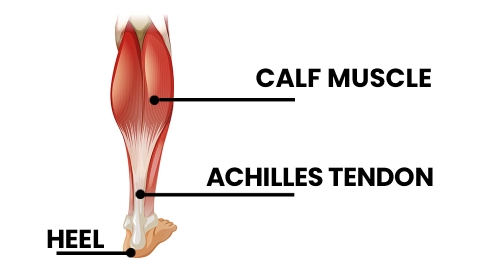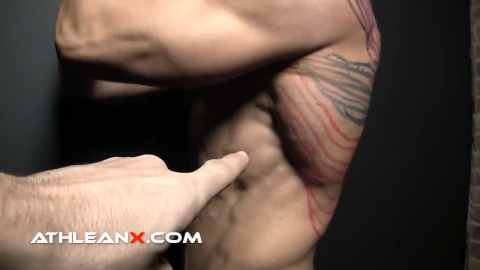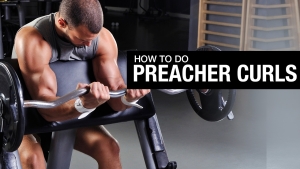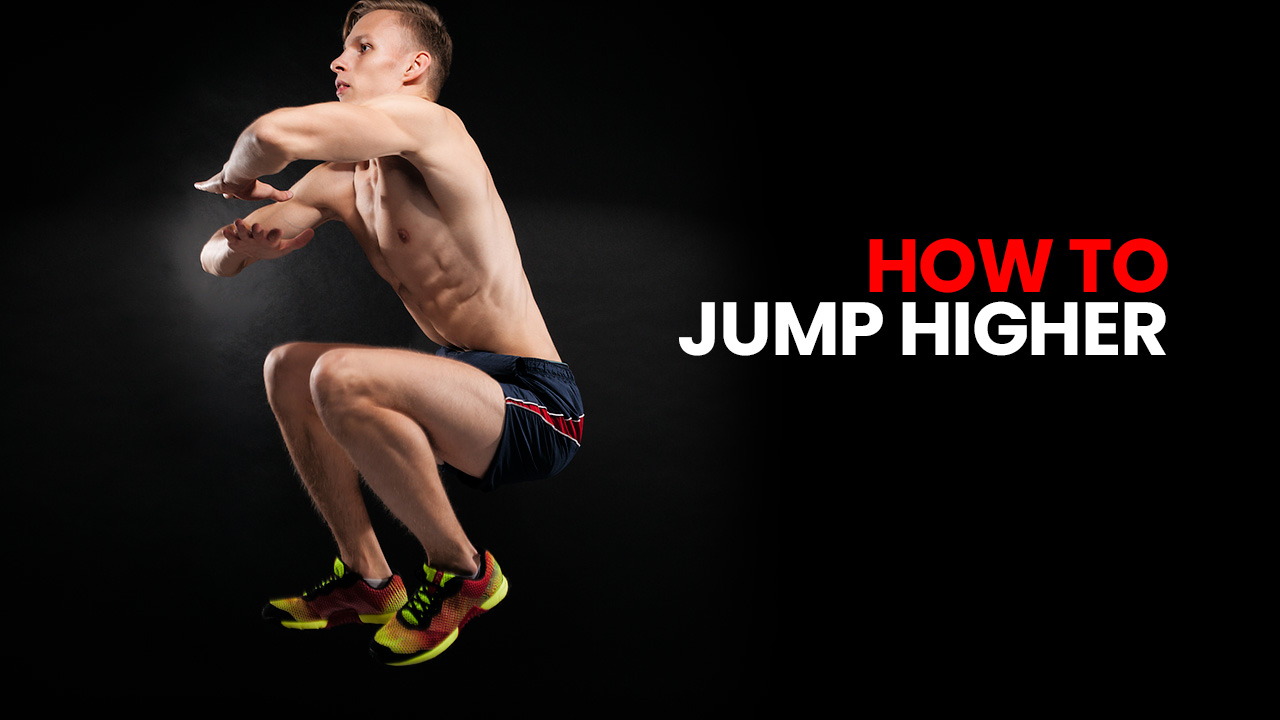
HOW TO JUMP HIGHER
It’s time to learn how to increase that vertical jump, but you’ve got to do me a favor.
Stop looking up and start focusing down on the ground because that’s where it all happens.
If you want to jump higher, you’re going to have to work for it.
That goes for everyone, from basketball players to the coach pushing them.
There are no short cuts or quick gimmicks to optimal health, performance, and level of flexibility.
That being said, as a trainer to professional athletes, I can tell you that there are some specific things that we work on that allow these guys to improve their vertical faster.
And I’m going to cover those things with you today.
Believe me, there’s more to jumping higher than the depth jump and the jump rope.
Let’s take a closer look at the muscle tissue and connective tissue involved in jumping and how to stretch to get these muscles ready.
We’ll also cover exercises you can do to get your entire body to jump higher in this vertical jump program.
WHAT MUSCLES ARE WORKED DURING A VERTICAL JUMP?
Let’s start off by first making sure we’re very clear on what we’re talking about when we mention increasing the vertical jump.
We’re talking about how high you can increase your center of gravity, meaning your core.
In other words, how high can you elevate your core off the ground?
You’re going to need to be able to go straight up in the air and get as high as you can.
So, with that being the focus, we need to zero in on a few key areas:
ACHILLES TENDON AND CALF MUSCLE
The Achilles tendon is a strong, rope-like tissue that links your calf muscles to your heel bone.
It’s the largest and strongest tendon in the human body, and it plays a crucial role in various physical activities, especially jumping.
When it comes to jumping, the Achilles tendon and calf muscle contribute in several important ways:
- Acts Like a Spring: Think of the Achilles tendon as a rubber band. When you get ready to jump by bending your knees and ankles, this ‘rubber band’ stretches and stores energy. Then, like a rubber band snapping back, it releases this energy to help push you up into the air.
- Helps with Power: Your calf muscles are the main muscles that you use to jump. The Achilles tendon takes the force from these muscles and uses it to push off the ground, giving your jump more power.
- Cushions Landings: When you land back on the ground, the Achilles tendon acts like a cushion, absorbing some of the shock and making the landing softer on your body.
- Keeps You Steady: It also helps keep your foot and ankle steady when you jump and land, so you don’t lose balance or hurt yourself.
HIP FLEXORS


The hip flexors are a group of muscles located around the upper thigh and pelvis. They include several muscles, the most notable being the iliopsoas, which is made up of the psoas major and the iliacus.
These muscles are crucial for many movements involving the hip and thigh. In terms of their contribution to jumping, the hip flexors play several key roles:
- Lifting the Legs: Hip flexors are primarily responsible for lifting your legs towards your chest. This action is essential during the initial phase of a jump. When you prepare to jump, you typically bend your knees and hips to lower your body. The hip flexors then contract to help lift your legs off the ground during the take-off phase of the jump.
- Generating Force: Along with other muscles in the legs and core, the hip flexors contribute to the overall force generated in a jump. Strong hip flexors can help produce more power, leading to a higher jump.
- Stabilizing the Lower Body: During a jump, the hip flexors also work to stabilize your pelvis and lower back. This stabilization is important for maintaining balance and ensuring that the force you generate in your legs is efficiently transferred into upward motion.
- Assisted Forms in Landing: When landing from a jump, the hip flexors help control the descent of your legs and aid in absorbing some of the impact.
LATISSIMUS DORSI
The latissimus dorsi, commonly known as the lats, are broad, flat muscles located on each side of your back, stretching from under the armpits to the lower back.
They are among the largest muscles in the upper body and play a crucial role in various movements involving the shoulders and arms.
While the lats are not the primary muscles used for jumping, they do contribute in several ways to the action:
- Upper Body Stability: The lats help stabilize the upper body during a jump. When you jump, your whole body is involved. Stable shoulders and a strong upper body provided by the lats can improve overall form and balance during the jumping motion.
- Arm Swing: During a vertical jump, swinging your arms upward can significantly contribute to the height of the jump. The lats are involved in controlling and powering this arm swing. By forcefully swinging your arms up, you create additional upward momentum, which can help lift your body higher.
- Coordination of Movement: The lats work in conjunction with other muscles of the back, shoulders, and core to coordinate the body’s movement during a jump. This coordination is essential for an efficient and effective jump, ensuring that all parts of the body move in harmony.
- Energy Transfer: In any dynamic movement like jumping, energy transfer through the body is important. Strong lats can help in the efficient transfer of energy from the lower body to the upper body, contributing to a more powerful jump.
CORE MUSCULATURE
The core musculature refers to the muscles in your midsection, encompassing not just the well-known “abs” (abdominal muscles) but also deeper muscles like the transversus abdominis, the obliques (on the sides), the lower back muscles, and even the muscles around the pelvis.
This group of muscles is fundamental for almost every physical activity, serving as a central link between your upper and lower body.
In the context of jumping, the core muscles play several crucial roles:
- Power Generation: For a strong jump, you need more than just leg strength. Your core muscles contribute to the generation of power. When you bend down before a jump, your core muscles engage, helping to create a sort of ‘coiled spring’ effect. As you launch into the air, this ‘spring’ releases, adding power to your jump.
- Stability and Balance: A strong core is essential for maintaining balance and stability both during the take-off and landing phases of a jump. It keeps your upper and lower body aligned, ensuring that the force you generate with your legs is efficiently transferred into vertical motion without any energy loss through excessive movement in your midsection.
- Controlled Landing: Upon landing, your core muscles help absorb some of the impact, reducing the risk of injury and preparing you for subsequent movements, whether it’s another jump or changing direction rapidly.
- Coordination: Core muscles are pivotal in coordinating the movement of your upper and lower body. A well-coordinated movement means a more effective jump, as the muscles work in harmony to produce a single, fluid motion.
HOW TO STRETCH TO JUMP HIGHER
Understanding the key muscles and tissues involved in jumping is step one. Now, let’s dive into preparing them for action.
It’s important not to rush into jumping without proper preparation.
Just like a car needs a warm-up on a cold morning, your muscles need to be warmed up, your heart rate needs to increase, and everything needs to be stretched to perform their best.
Let’s explore how targeted static stretching can elevate your jumping ability, ensuring your muscles are limber and ready for that powerful leap.
An ideal warm-up exercise would include some dynamic stretching. Leg Swings, Arm Circles, and Side to Side Twists are all examples of dynamic stretches.
Here’s how to stretch so that you can jump higher in this vertical jump training program.
ACHILLES TENDON STRETCH

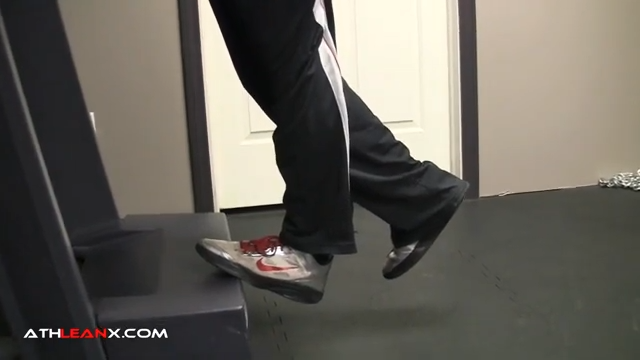
HOW TO DO THE ACHILLES TENDON STRETCH:
- Start in a standing position on a step with your heel hanging off the edge.
- You’ll be doing two variations of this stretch:
- First, keep your knees straight and gently lower your heels below the step until you feel a stretch in the back of your legs, targeting the gastrocnemius muscle of your calf.
- Hold this position for several moments.
- For the second variation, bend your knees slightly while performing the same movement.
- This slight bend targets the soleus muscle, which is also part of your calf.
- Again, hold the proper form for these positions for several moments. Switch sides when you finish your reps.
WHAT MAKES IT EFFECTIVE: Both calf muscles connect into the Achilles tendon, so by doing both the straight-leg and bent-knee stretches, you’re ensuring a comprehensive stretch of the entire calf area and the Achilles tendon.
HIP FLEXORS STRETCH

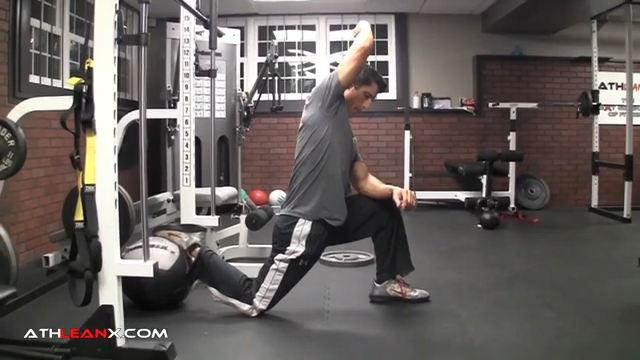
HOW TO DO THE HIP FLEXORS STRETCH:
- Begin by stepping forward into a basic lunge position. Place your right foot forward and your left foot back, keeping both feet pointing straight ahead. Be sure to keep your right foot flat on the ground.
- Bend your right knee so it’s at a 90-degree angle, with your thigh parallel to the ground, and extend your left leg behind you, resting on the ball of your back foot.
- Make sure your front knee is directly over your ankle and not pushing past your toes.
- Keeping your hips square and facing forward, shift your weight slightly forward until you feel a stretch in the front of your left hip and glutes – this is your hip flexor stretching throughout this range of motion.
- While maintaining the lunge and hip flexor stretch, raise your left arm (the same side as your extended leg) straight up and over your head.
- Gently lean to your right side, away from your extended leg, and push your hips slightly forward. You should feel a deeper stretch along the left side of your body, from your hip flexor up through your abdomen and into your arm.
- Spend at least a minute on this stretch.
WHAT MAKES IT EFFECTIVE: Think about the explosiveness of the jump. When you reach up, and you’re in triple extension – through your hips, ankles, and knees – you want to make sure that you can extend the trunk as high as you can. The only way you’re going to be able to do that, to reach full extension, is to not have any restrictions from your hip flexors trying to pull you, and your trunk, downward.
LATS / CORE STRETCH

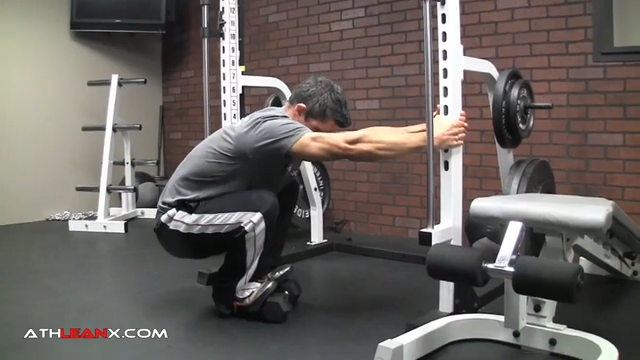
HOW TO DO THE LATS/CORE STRETCH:
- Place your feet on a dumbbell near a Smith machine, squat rack, or stable support structure – Be sure you have a solid foundation.
- Go down into a squat workout position – a deep stretch – while holding the squat rack and placing your head down.
- You’ll feel the initial stretch throughout your groin, hips, and Achilles tendon.
- Now begin to reach up and climb to extend the lats and core upward.
- Continue upward until you feel a nice stretch throughout your upper body.
- Hold here for 30-60 seconds.
WHAT MAKES IT EFFECTIVE: I want to make sure that I’m stretching out my lats and core at the same time as my lower body. This stretch effectively releases the tension in a tight lat or core muscle, allowing you to extend up more during a jump.
HOW TO JUMP HIGHER: PRINCIPLES
We’ve covered the muscles and tissue you want to focus on to jump higher along with the best stretches for those areas.
Now, we’re going to focus on the two main principles for learning how to jump higher.
Number one: You have to learn how to drive your feet into the ground harder.
And number 2: You need to learn how to drive your feet into the ground faster.
HOW TO DRIVE YOUR FEET HARDER
Now, when we talk about harder, we’re talking about your ground force production.
Another way to look at it: How hard can you push into the ground so that there’s an equal and opposite reaction in the opposite direction?
Why so much focus on the ground?
Interestingly, when they did the vertical jump testing in the combines of the NFL, they found that by far, NFL players had a more successful jump than the guys tested in the NBA.
Seems backward, right? Why did the NFL players have a better vertical jump height when jumping isn’t required in football?
One reason is strength.
We’re talking about defensive linemen, closing in on 300 pounds, being able to jump higher than the average NBA player because it comes down to strength.
The more force that you can exert into that ground with equal and opposite reaction, and the quicker you can do it, the more you’re going to be able to get up in the air.
HOW TO DRIVE YOUR FEET FASTER
Secondly, we have the speed at which you can drive your feet into the ground. This is called the rate of force production.
Put another way: How quickly can we push ourselves into the ground so we can then again push with more lower body explosiveness, or a more reactive, elastic force off of the ground?
It’s important to understand that jumping higher isn’t just about raw strength; it’s also about the speed of your movement.
The faster you can apply force to the ground, the quicker your muscles and tendons react, creating a more powerful and explosive upward thrust.
This rapid application of force helps in engaging the elastic properties of your muscles and tendons more effectively.
HOW TO PUSH HARDER: EXERCISES
Let’s start with building more strength.
Here are the best exercises to help you push harder into the ground and generate more force.
TOE SQUATS

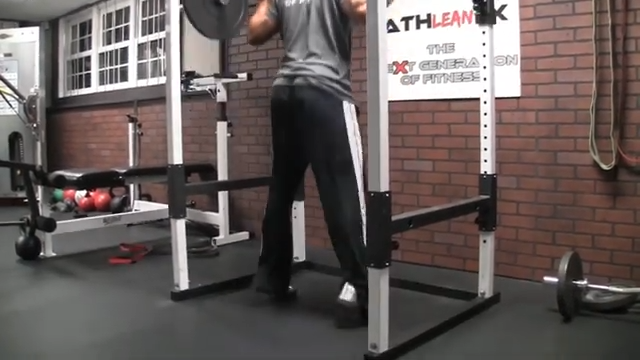
HOW TO DO TOE SQUATS:
- Stand under the barbell so it rests on your upper back (trapezius muscles), just below the neck.
- Grip the barbell wider than shoulder-width apart, with your hands facing forward. Keep your elbows pointed down and your wrists straight. Unrack the bar by straightening your legs and stepping back from the rack.
- Take a deep breath and hold it, then bend your knees and hips to lower your body. Imagine you’re sitting back into a chair. Keep your chest up and your back straight, with a slight natural arch in your lower back.
- Watch your knees, making sure they don’t come together when coming down. This is called knock knee.
- Aim to lower yourself until your hips are at least parallel with your knees (thighs parallel to the floor).
- Push through your heels to stand back up, keeping the barbell balanced and your core engaged. Exhale as you rise.
- Your focus is not just to come up with the weight, but to accelerate up with the weight, and not stop when you reach the top. Come all the way through and focus on trying to push up onto your big toe.
WHAT MAKES IT EFFECTIVE: Think of this exercise like a squat with calf raises at the end. The flexor hallucis longus, a muscle that extends across the ankle joint and attaches to the big toe, plays a crucial role in flexing the big toe. By strengthening this muscle, you can enhance the power of your final toe push-off during a jump.
HEAVY KETTLEBELL SWINGS

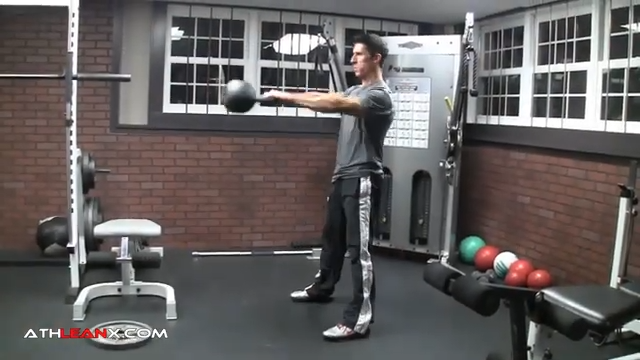
HOW TO DO KETTLEBELL SWINGS:
- Position yourself with your feet set a bit wider than the width of your hips, toes either pointing straight ahead or angled slightly outwards. Set the kettlebell on the ground about one foot ahead of where you are standing.
- Bend at your hips and knees, keeping your back flat, and grasp the kettlebell handle with both hands. Your palms should face your body, and your shoulders should be relaxed.
- Engage your core and lift the kettlebell off the ground, allowing it to swing back between your legs in a controlled manner.
- Powerfully extend your hips and knees to swing the kettlebell forward and up. Your arms are not doing the lifting; they’re merely guiding the kettlebell. The motion should come from the thrust of your hips.
- The kettlebell should swing up to about chest height. Keep your arms straight and your core engaged. Your body should form a straight line at the top of the swing, from your head to your knees.
- Allow the kettlebell to swing back down through your legs. As it descends, hinge at your hips and slightly bend your knees. Keep your back straight and abs engaged.
- Continue to powerfully drive your hips forward and swing the kettlebell up and down. Remember to breathe: exhale as you swing the kettlebell up, and inhale as it swings back between your legs.
WHAT MAKES IT EFFECTIVE: We’re working with a heavier version of a Kettlebell Swing, and the focus is on getting triple extension – extending powerfully through our ankles, knees, and hips.
HEAVY SLED / PROWLER PUSH

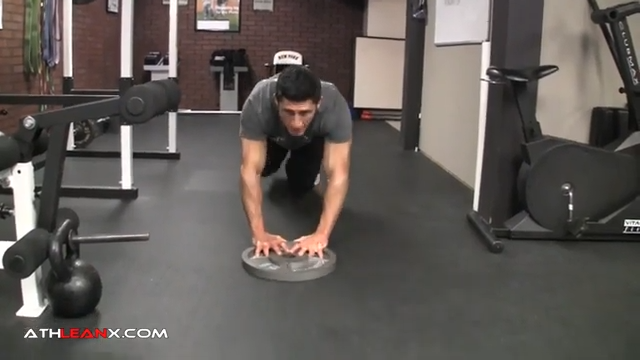
HOW TO DO THE HEAVY SLED / PROWLER PUSH:
- Stand behind the sled or prowler, facing it. Place your hands on the handles or bars, depending on the design of your equipment. Your arms should be straight and slightly lower than shoulder height.
- Position your feet about shoulder-width apart. Keep your back straight and lean forward slightly, so your body is at an angle. Tighten your core muscles.
- Drive through your heels and extend your legs to push the sled forward. Your entire foot should press into the ground as you push to engage your leg muscles effectively.
- As you push, keep your back straight and your hips low. Avoid arching your back or letting your hips rise too high, as this can put unnecessary strain on your back.
- Once the sled is moving, continue to walk or run forward, pushing the sled in front of you. Keep your lower body movements smooth and consistent. Focus on driving with your legs while maintaining a straight line from your shoulders to your feet.
- Now, you may not have access to a weighted sled or prowler. In that case, you can use a heavy weight plate and push it as fast as you can against this surface. You can perform this exercise both indoors and outdoors on the grass.
WHAT MAKES IT EFFECTIVE: This method increases force production, enabling you to push more forcefully against the ground. As a result, you can propel your body upwards more effectively, thanks to the principle of equal and opposite reactions.
HOW TO PUSH FASTER: EXERCISES
You know how to increase your strength and ground force to jump higher, now we need to work on your speed.
Admittedly, you’ll use most of the same exercises, but you’ll focus on using a lighter load and moving it as fast as possible.
Here are some of the best exercises to help you push faster and make you jump higher.
ACCELERATIVE BOX JUMPS

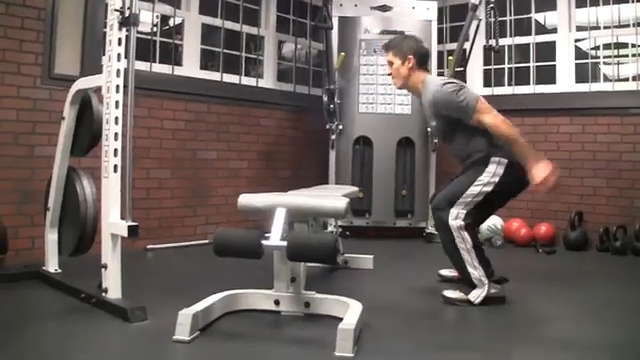
HOW TO DO ACCELERATIVE BOX JUMPS:
- Let’s throw in one of my favorite jump-specific exercises. Select a box or stable platform that is a comfortable height for you. It’s important to start with a height that you can safely jump onto without risking injury. As you become more proficient, you can gradually increase the height.
- Position yourself about an arm’s length away from the box, with your feet shoulder-width apart. Ideally, you’ll be standing on a jump pad. This is your starting position for one of the 2-foot jumps you’re able to do to improve your vertical and jump shot.
- Begin by quickly lowering your body into a shallow squat. This is a preparatory movement to help generate power for the jump.
- From the quarter squat, swing your arms and explosively jump up onto the box. Push through the balls of your feet and use the momentum from your arms to help propel you upward.
- Aim to land softly on the box with both feet at the same time. Your knees should be slightly bent to absorb the impact. Ensure you are landing securely on the box and not on the edge.
- Once you’ve landed on the box, straighten your legs to stand up completely.
- Carefully step back down from the box, one foot at a time, and reset to your starting position.
WHAT MAKES IT EFFECTIVE: If you want to jump higher, you have to increase the speed at which you are attacking the ground. You do that by actually increasing the speed at which you lower your body to create that stretch reflex to give you that rate of force production that will propel you up higher.
LIGHT KETTLEBELL SWINGS

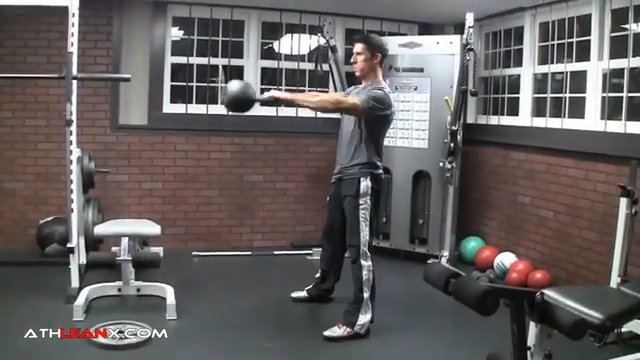
HOW TO DO LIGHT KETTLEBELL SWINGS:
- Choose a lighter weight as your focus here is to move as quickly and safely as possible.
- Stand with your feet slightly wider than hip-width apart. Position your toes either pointing straight ahead or slightly outward. Place the kettlebell on the ground about a foot in front of you.
- Hinge at your hips and slightly bend your knees, maintaining a flat back. Reach out and grip the kettlebell handle with both hands, palms facing towards you. Ensure your shoulders are relaxed.
- Tighten your core muscles and lift the kettlebell off the ground. Let it swing back between your legs in a smooth, controlled motion.
- Using the power of your hips and knees, extend them forcefully to propel the kettlebell forward and upward. Remember, the lift comes from the hip thrust, not your arms; your arms are simply guiding the kettlebell.
- Swing the kettlebell up to roughly the height of your chest. Keep your arms extended and your core muscles tight. At the top of the swing, your body should create a straight line from your head down to your knees.
- As the kettlebell begins its descent, hinge at your hips and softly bend your knees again. Keep your back straight and your abdominal muscles engaged to support your spine.
WHAT MAKES IT EFFECTIVE: The focus here is not just trying to overcome a strong force to increase our ability to push harder, but now we want to be able to translate that to be able to push faster. We lighten the load, and this allows us to move explosively in our Kettlebell Swing.
LIGHT SLED / PROWLER PUSH

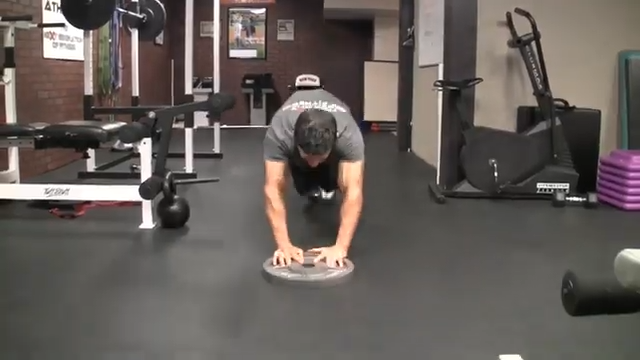
HOW TO DO THE LIGHT SLED / PROWLER PUSH:
- Whether you’re using the sled or a simple weight plate, go light for this one.
- Stand at the rear of the sled or prowler, facing it. Place your hands on the handles or bars. Your arms should be extended and positioned slightly below the height of your shoulders.
- Set your feet at shoulder width. Keep your back straight and lean forward at a slight angle. Engage your core muscles to stabilize your torso.
- Drive through the balls of your feet, extending your legs to propel the sled forward. Ensure your whole foot makes contact with the ground for effective muscle engagement.
- As you push, keep your back straight and hips low. Be mindful not to arch your back or let your hips rise excessively, which could lead to back strain.
- Once the sled is in motion, walk or run forward swiftly, continuing to push the sled. Aim for smooth, steady movements. Focus on driving powerfully with your legs, keeping a straight line from your shoulders down to your feet.
- If you don’t have a sled or prowler, you can use a heavy weight plate on a suitable surface. Push the plate rapidly across the surface, either indoors or outdoors, such as on grass.
WHAT MAKES IT EFFECTIVE: Just like with the Kettlebell Swing, by decreasing the amount of weight you’re using, you’re able to focus on increasing your speed.
ENHANCING VERTICAL LEAP: KEY STRATEGIES
Now that you have your stretches and exercises, here are some other things to consider to improve your vertical leap.
Think of these like helpful reminders.
EXERCISE FOCUS AND SELECTION FOR OPTIMAL PERFORMANCE
Athletes seeking to jump higher must prioritize their exercise selection.
The emphasis should be on explosive exercises that activate fast-twitch muscle fibers, crucial for quick, powerful movements.
Notably, a combination of exercises that improve core strength, calf muscle development, and overall leg power are a game changer for athletes.
Exercises such as Kettlebell Swings and Dynamic Swing Blocks can significantly improve ground contact times and overall performance.
Core stability, achieved through exercises like Glute Bridges and the Glute Ham Raise, is pivotal for maintaining a proper position during jumps and reducing the risk of knee injury.
FLEXIBILITY AND INJURY PREVENTION: THE ROLE OF DYNAMIC STRETCHING
A dynamic stretching warm-up enhances flexibility and prepares the muscles for the stress of jumping.
This routine can include ankle stretches and exercises promoting deeper knee bends, essential for achieving the ideal degrees of knee bend during a jump.
It also addresses ankle mobility concerns, thereby preventing potential ankle injuries.
ADVANCED TECHNIQUES FOR EXPERIENCED ATHLETES
For the more experienced athletes, advanced techniques like the Dumbbell Shoulder Press in a half-squat position can be introduced.
This not only works on leg power but also incorporates a bit of core stability, enhancing the athlete’s overall explosive capacity.
Additional advanced techniques include:
- Plyometric Depth Jumps: These involve jumping from a raised platform to the ground, and immediately exploding upwards. This trains reaction time and explosive power.
- Olympic Weightlifting Variants: Movements like the Power Clean and Snatch are excellent for developing explosive strength and coordination.
- Single-Leg Exercises: Single-Leg Squats and Lunges increase unilateral strength and balance, important for the asymmetrical nature of many sports.
- Weighted Jump Squats: Using a barbell or dumbbells; these add resistance to the jump, increasing power and strength in the legs.
Incorporating these advanced exercises can lead to significant improvements in vertical leap for experienced athletes, especially when combined with proper technique, rest, and nutrition.
So, there you have it, guys. This is how you start to jump higher by training the right way.
Surprisingly enough, getting better at jumping requires more than just jumping.
You need to incorporate strength and speed into your training program.
Don’t have a lower body strength training workout? We’ve got you covered! To get strong, ripped and athletic at the same time, check out our ATHLEAN-X programs.

- To increase your vertical jump is a question of how high you can increase your center of gravity, meaning your core off the ground.
- You want to target certain muscle groups to improve your jumping ability, specifically the Achilles tendon, calves, hip flexors, lats, and core.
- Start by stretching these muscle groups, preparing them for the challenging exercises and speed drills that follow.
- Once you’re stretched out, use Toe Squats, Kettlebell Swings, and Sled Pushes to build explosive strength in your lower body.
- Follow these exercises with speed-building movements including Box Jumps.
- Incorporate these exercises into an athletic-focused program that also includes jumping drills.
- Above all, be consistent with doing your exercises and measuring your progress.
HOW TO JUMP HIGHER FAQS
You can increase your vertical jump by focusing on both strength and speed training. The goal is to increase both your ground force production and your rate of force production.
To increase ground force production, focus on building explosive strength in the lower body with exercises like Toe Squats, Heavy Kettlebell Swings, and Heavy Sled Pushes.
To improve your rate of force production, use exercises like Body Weight Box Jumps, Light Kettlebell Swings, and Light Sled Pushes.
Incorporate these movements into your athletic training program or weekly workouts.
Absolutely, if you want to jump higher, you need to do more than jumping. You need to increase your strength (ground force production) and speed (rate of force production).
To enhance ground force output, concentrate on developing explosive power in your lower body. This can be achieved through exercises such as Toe Squats, Heavy Kettlebell Swings, and Heavy Sled Pushes.
For boosting your force production speed, incorporate exercises like Box Jumps, Light Kettlebell Swings, and Light Sled Pushes into your routine.
To improve your high jump, focus on a combination of strength training, plyometrics, and technique refinement.
Build explosive lower body strength with exercises like Kettlebell Swings, Toe Squats, and Sled Pushes.
Improve your speed with explosive exercises like Box Jumps, Light Kettlebell Swings, and Light Sled Pushes.
Also, don’t forget to include stretches that target the muscles and connective tissue that make the high jump possible. Specifically, focus on stretching your Achilles tendon, calves, lats, and core.
Measure your jumping progress with a measuring tape and video footage. Continue to work at it, building strength and speed in the process.
Jumping four feet high is no small feat. To get to this level of athletic ability, you’ll want to utilize a combination of strength, power, technique, and practice.
Focus on explosive exercises that increase strength in your legs and core such as Toe Squats, Kettlebell Swings, Sled Pushes.
You should also use bodyweight exercises like Box Jumps.
A strong core aids in stability and power generation during the jump. Incorporate exercises like Planks and Russian Twists.
Work on your jumping mechanics. This includes your approach, take-off, and how you use your arms to gain momentum. A proper take-off, with knees bent and arms swinging upwards, can significantly enhance jump height.
Consistent practice is key. Jumping exercises not only improve technique but also condition your muscles for high jumps.
Yes, it is possible to increase your vertical jump by six inches, but it requires dedication, consistent training, and the right approach.
Start with stretching the Achilles tendon, calves, hip flexors, lats, and core. It’s important to prepare the muscles for the workload to come.
Next, focus on exercises that build explosive strength in your lower body, such as Toe Squats, Sled Pushes, and Kettlebell Swings. Bodyweight leg exercises like Box Jumps also play a big part in building stronger leg muscles that contribute significantly to jumping height.
Finally, your jumping form and consistently working on it is crucial. Practice your take-off and landing mechanics, as well as how you use your arms to generate momentum.
REFERENCES

Jeff Cavaliere M.S.P.T, CSCS
Jeff Cavaliere is a Physical Therapist, Strength Coach and creator of the ATHLEAN-X Training Programs and ATHLEAN-Rx Supplements. He has a Masters in Physical Therapy (MSPT) and has worked as Head Physical Therapist for the New York Mets, as well as training many elite professional athletes in Major League Baseball, NFL, MMA and professional wrestling. His programs produce “next level” achievements in muscle size, strength and performance for professional athletes and anyone looking to build a muscular athletic physique.
















